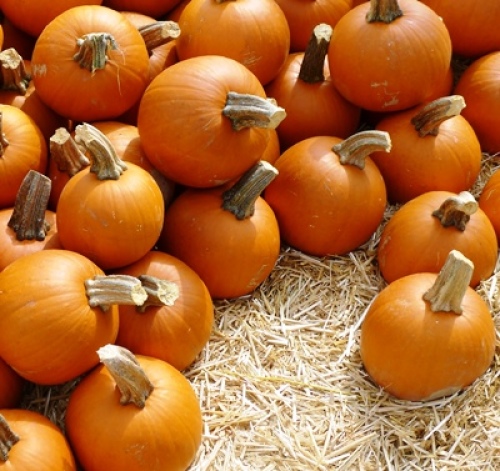
The National Garden Bureau (NGB) has selected its Plants of the Year for 2019, and vegetable gardeners should be especially pleased. Pumpkins are the edible to celebrate this year.
The NGB selects fruits, flowers and other crops that are “easy to grow, genetically diverse and with a lot of new breeding to showcase.” Pumpkins certainly meet all of those requirements.
It took hundreds of years for pumpkins to develop into the colorful fruits of the Cucurbita pepo we enjoy today. Most people are familiar with the large orange carvable pumpkins at Halloween, but there’s much more to these beautiful fruits. They make nice fall decorations, but they’re also nutritious. One look at the bright orange interior of pumpkins let’s us know they’re loaded with beta-carotene, a powerful antioxidant.
Pumpkins are also fun to grow, and there’s a perfect variety for every garden. Here are six All-America Selections winners to grow in your vegetable garden this year:
Wee-B-Little (1999 winner). These pint-sized pumpkins are perfect for small-space gardens because they grow on bush-type plants. The small, 8 ounces fruits need only 8 feet of growing room and will mature in about 120 days.
Baby Bear (1993 winner). Baby Bear is a small-size sugar pumpkin for gardeners who like to bake their own pumpkin pies. Pumpkins grow to be about 1.5-2 pounds and need room for their vines. Count on 105 days to maturity from planting.
Pepitas (2016 winner). For gardeners wanting a pumpkin that’s decorative and edible, Pepitas fill the bill. These 9-12 pound fruits are orange-yellow with green stripes. They get their name from the seeds that are easy to roast and eat because they lack a tough outer hull. Pepitas take about 90 days to reach maturity.
Super Moon (2016 winner). White pumpkins add a ghostly touch to fall decorations, and Super Moon is a good choice. These pumpkins typically grow to 25-30 pounds and are known to be hardy and disease resistant. In addition to their smooth white skin, they have a bright orange interior to use in cooking. 90 days to maturity.
Cinderella’s Carriage (2014 winner). The ideal fairy tale pumpkin, Cinderella’s carriage is bright orange-red with a flat round shape. This hybrid has good resistance to powdery mildew and will grow to about 18-20 pounds. Plan on 100 days to harvest from planting.
Sorcerer (2002 winner). A full-sized pumpkin that grows to 15-20 pounds on compact (10-foot vines), Sorcerer makes an excellent carving pumpkin. These fruits have a deep round shape and very stout stems. Harvest in about 100 days from planting.
Plant pumpkins in full sun with plenty of space for the vines to spread. Make sure you leave space to walk in the garden without harming the vines or fruit. Amend the soil by digging in compost and well-aged manure.
Because pumpkins can take 100 days to mature, some gardeners prefer to plant transplants instead of direct sowing seeds in the garden. If you’re starting your own transplants, plant seeds indoors about 4-6 weeks before the average last frost date.
Wait for the soil to warm to between 60-80 degrees before planting. Pumpkins do best when they start in warm soil. Be sure to acclimate (harden off) transplants before planting in the garden by exposing them slowly to sunny conditions.
Space plants according to the variety, so read seed packets or transplant stakes carefully. In general, plant seeds about ½ to 1 inch deep and about 24-36 inches apart; rows about 48 inches apart. Plant transplants about 12 inches apart in each row.
Set up a drip irrigation system or a soaker hose to ensure the pumpkin plants will get adequate water through the season. A layer of organic mulch will help maintain soil moisture and eliminate weeds.
Keep up with watering and don’t let the soil dry out. Make sure to keep leaves dry to prevent any foliage diseases from developing.
As vines begin to grow, sidedress the plants with a nitrogen fertilizer. Sprinkle a dry fertilizer along the rows of plants, about 6-8 inches away from the plants, then carefully rake in so you don’t disturb roots or vines; then water in the fertilizer.
Keep track of the number of days to harvest for the type of pumpkins you planted, and use that as a guide for when to harvest.
Pumpkins need to have a hard outer rind before they can be cut from their vines. To test the rind, press your fingernail into the skin; if it resists puncture, the fruit is ready to pick. Use a sharp knife or pruners to cut fruits from the vine, but leave a length of stem attached. Let fruits cure in a shed or garage for several days to help with long-term storage.
When cured, pumpkins can be used for decorating, eating and celebrating.
Fine Gardening Recommended Products

Berry & Bird Rabbiting Spade, Trenching Shovel
Fine Gardening receives a commission for items purchased through links on this site, including Amazon Associates and other affiliate advertising programs.

Gardener's Log Book from NYBG
Fine Gardening receives a commission for items purchased through links on this site, including Amazon Associates and other affiliate advertising programs.

Razor-Back Potato/Refuse Hook
Fine Gardening receives a commission for items purchased through links on this site, including Amazon Associates and other affiliate advertising programs.



















Comments
Log in or create an account to post a comment.
Sign up Log in